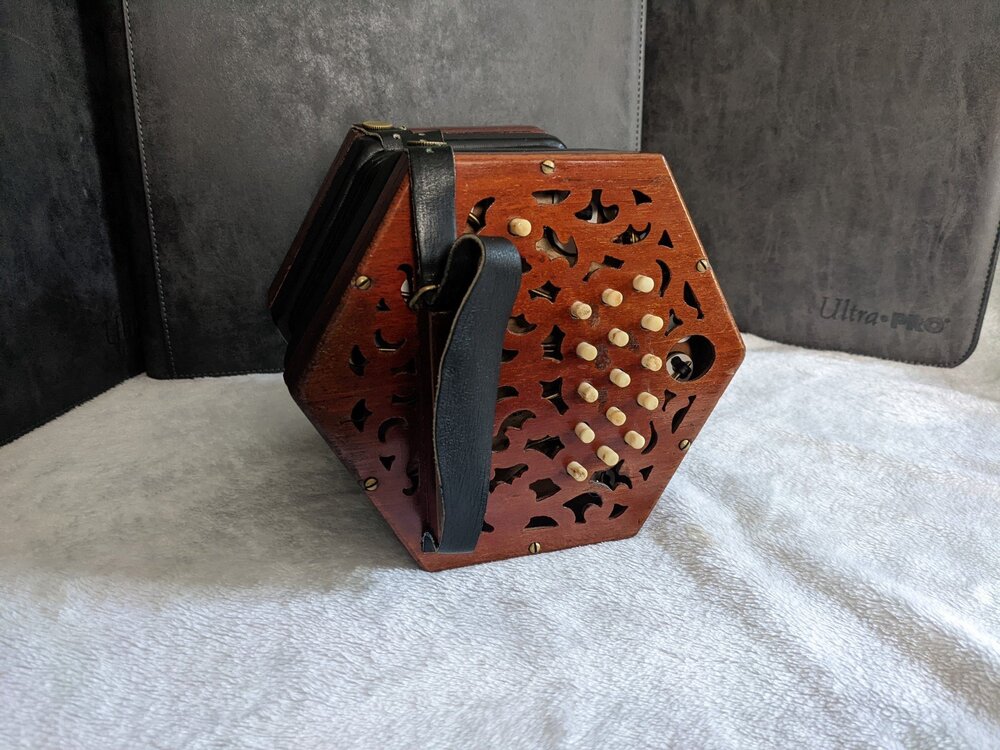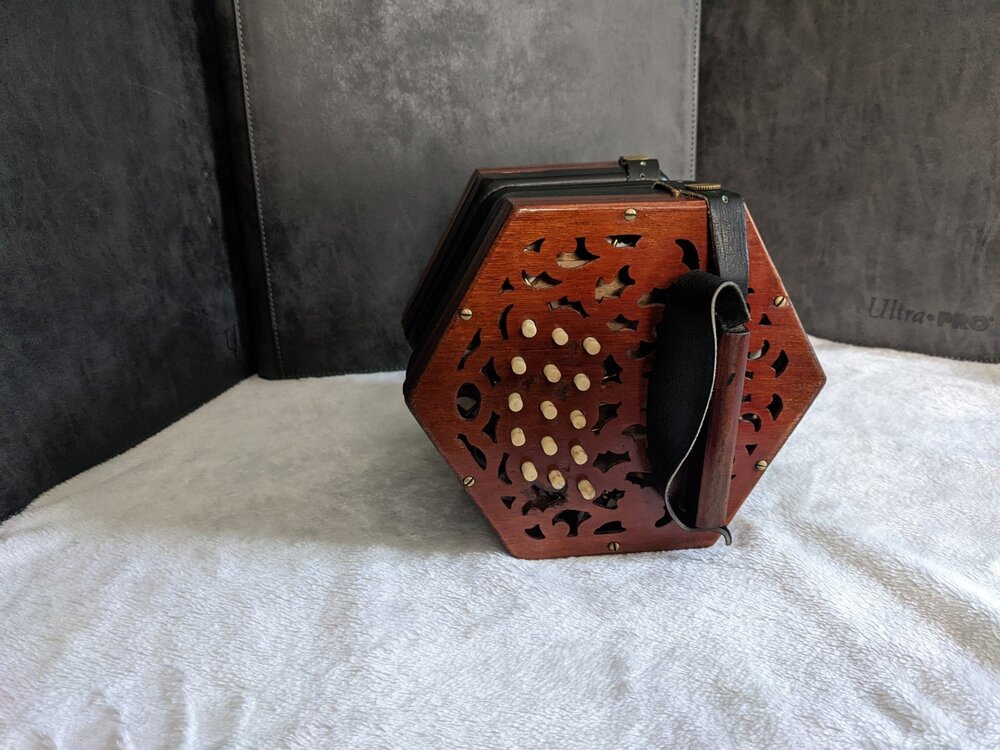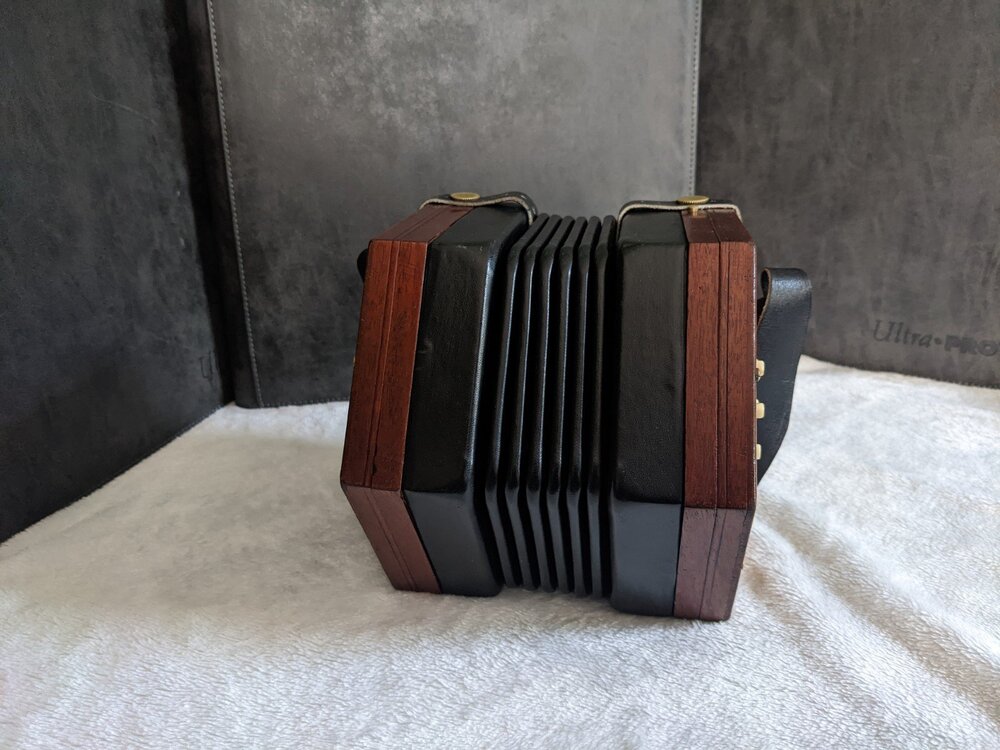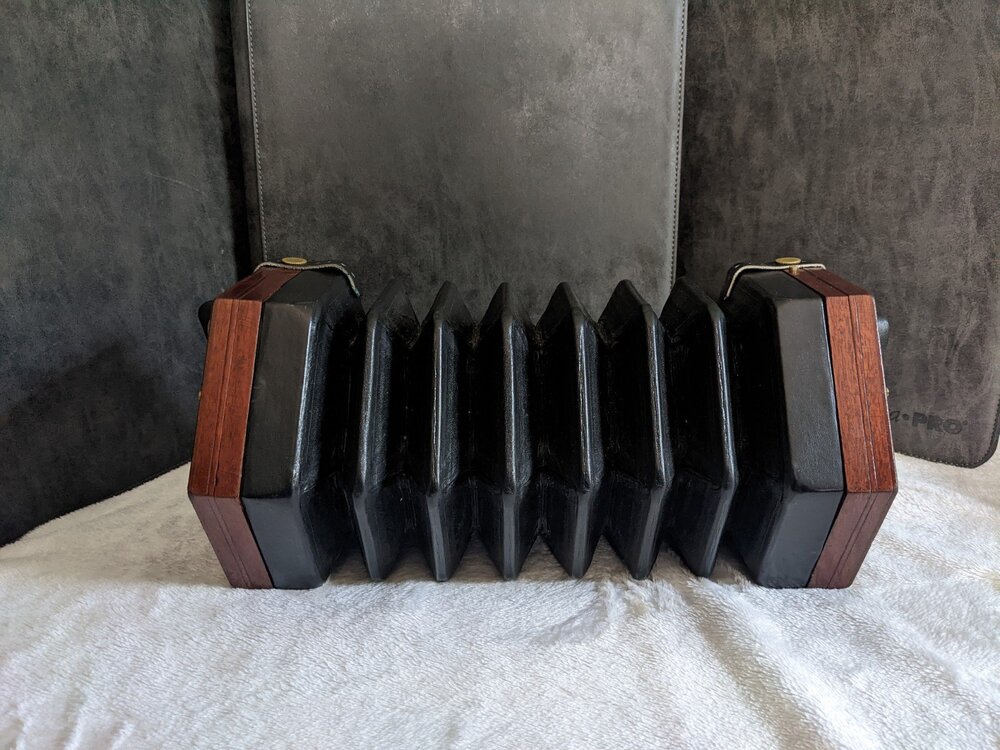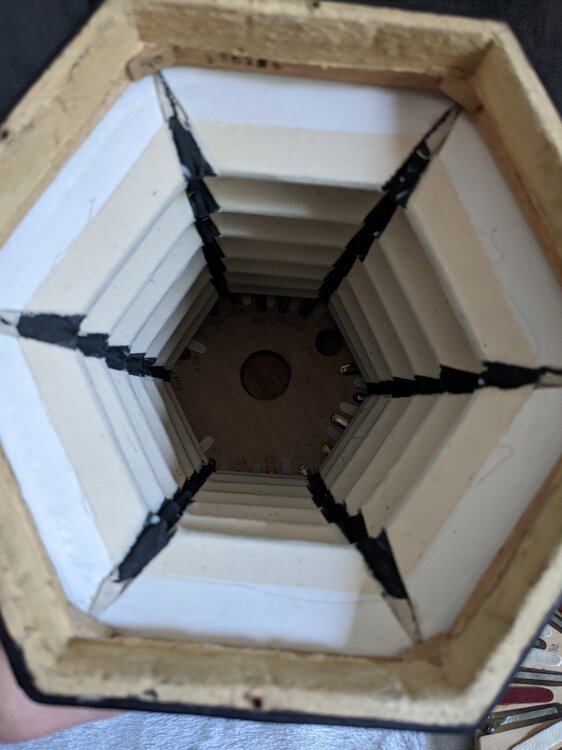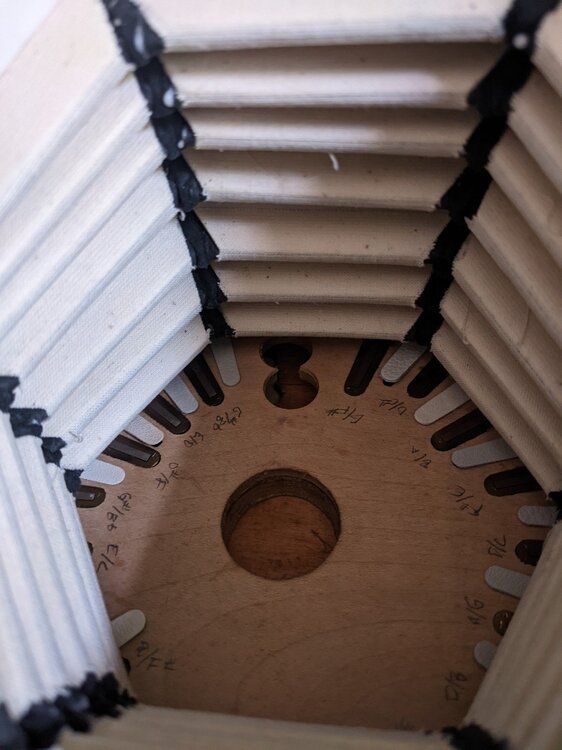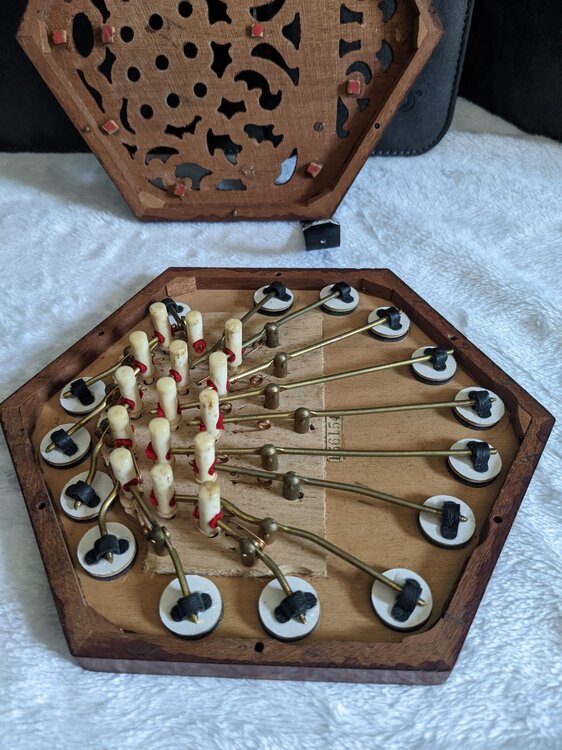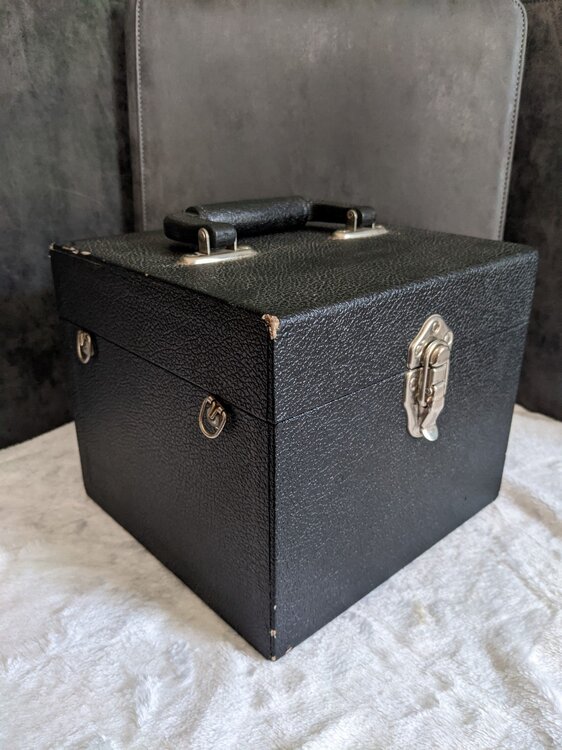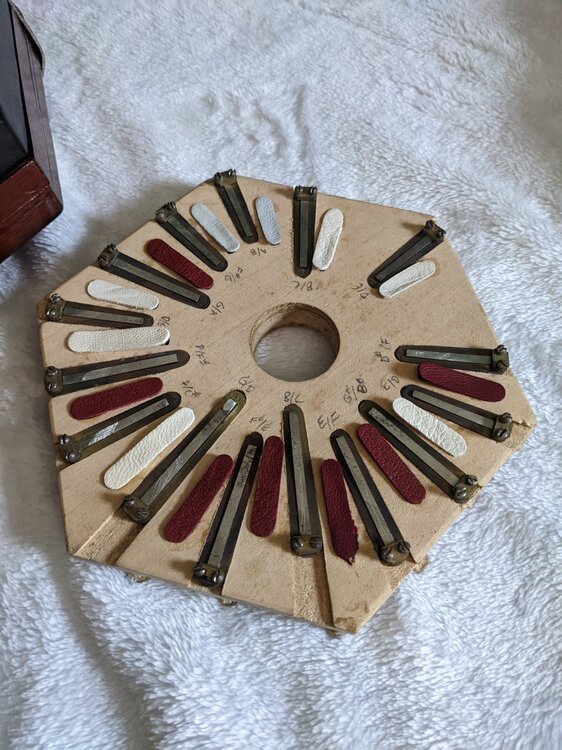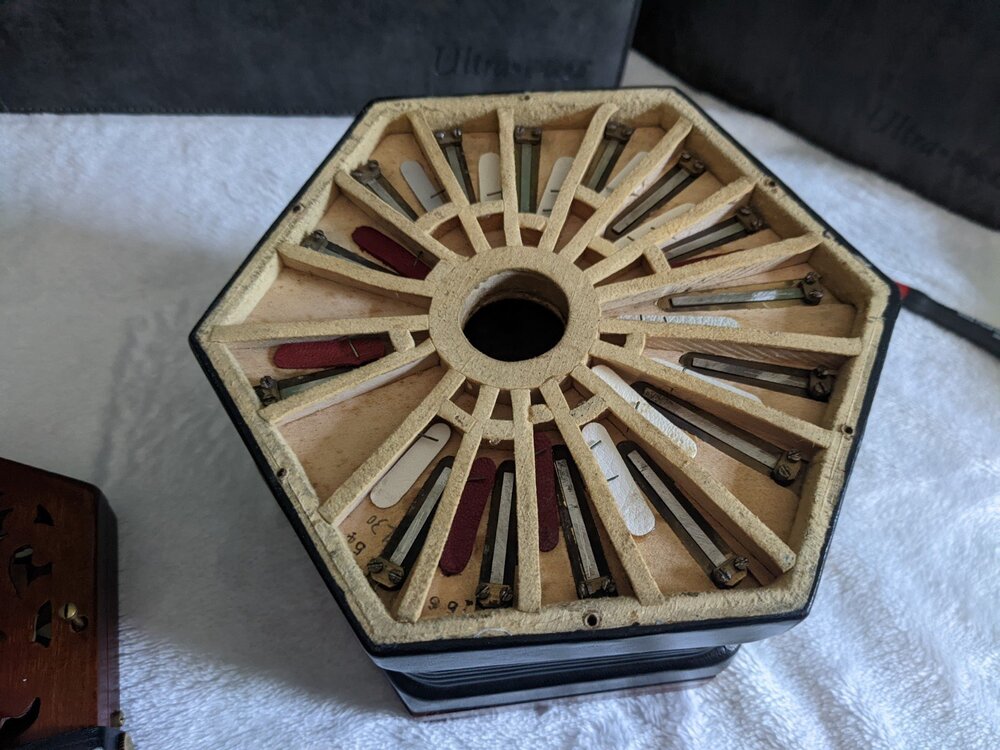-
Posts
176 -
Joined
-
Last visited
Profile Information
-
Gender
Male
-
Interests
Anglo concertina player. Morris and Irish music.
-
Location
Philadelphia
Recent Profile Visitors
879 profile views
DavidFR's Achievements

Chatty concertinist (4/6)
-
Hi Leah, I have an 30-button GD for sale, please PM if interested. My for sale post is still active in this forum.
-
I'm looking to see if there's any interest in my 30b G/D Lachenal, #156154. I'm the lucky owner of a 38b Holden, and don't play this very much any more. It's a little hard to let go, but it should be played more. This is a mahogany-ended, steel-reed instrument that was originally in Ab/Eb and likely made for the Salvation Army marching band. It has the hardware to attach a marching band music holder, though I was never able to source one. It was rebuilt by Paul Groff, with Connor riveted action and Connor custom 6-fold bellows, and tuned down a half step to G/D. He also removed the baffles and enlarged the air button capacity. I've had it in once to the Button Box for minor repairs, but it's been a reliable instrument for me otherwise. I think it has a beautiful tone - but more mellow and less strident than a metal ended box; and it's as fast and responsive as you'll get from a low-pitch Lachenal. I'm asking $4,000. The instrument is in the Philadelphia area, and comes with a used custom-blocked case from the Button Box. Please reach out with any questions!
-

Players in the MD-VA-DC Areas
DavidFR replied to Randy Stein's topic in General Concertina Discussion
Where are you going to hold it? I'm in Philly and might be interested in coming down if it's not too far. -David -
I recently moved to Philadelphia. Anyone care to recommend an Irish or English session in the area? -David
-

Anglo players - how/what do you play?
DavidFR replied to LDT's topic in General Concertina Discussion
I probably should have clicked other, but I put myself in melody rh chords lh English, since I'm doing more of that these days. It's more accurate to say that I'm split fairly evenly between morris music (a la Tom Kruskal and John Roberts), and Irish music (major influencers are Noel Hill and Frank Edgley). Some of my playing is very along the rows, but more and more I'm using various alternate fingerings that make sense for the particular tune and/or chords I want to use. What's annoying is when I have something all figured out, and I transpose from my G/D to my C/G or vice versa, and it doesn't quite work. -
Does anybody know of anyone giving concertina lessons (either Irish or English style) in the Greater Boston (MA) area? Thanks in advance!
-
Richard, I completely agree with you. Unless there are known issues with the concertina - ie it's been stolen, or is somehow defective and that's not being disclosed - it is not nice to trash other people's instruments. -David
-
Wim, Do you have any concerns, given the "variable" nature of the end result of the kits, that some folks might try to pass off kits as regular clovers? Will you use some sort of alternate numbering system to differentiate? -David
-
Yes, it should be fine. Most restored Lachenals that I've seen have had the baffles removed. I would guess that baffles were originally put in to make them quieter, as a "parlor" instrument perhaps for use in polite company. We modern-day concertinists tend to be more impolite. -David
-
So here is my review. Pictures to follow once I have time to resize them at work - they are sort of enormous right now. Review of Kensington 031 Kensington 031 is a 30-button concertina in C/G, with Dana Johnson’s standard modified Jeffries layout. Construction: The ends are pierced nickel silver in what seems an approximation of a traditional pattern, except that the maker’s mark (LH side) and serial number (RH side) are stamped in ovals central to the pattern (just below the buttons) rather than on top. Instead of wood, Dymond Wood in a reddish-brown hue is used for the “wooden” part of the ends and the handrails. The handrails, rather than being flat as in most traditional instruments, are curved to fit the shape of your palms as you play. The handstraps are a thick reddish-brown leather with black edging, are screwed in just below the thumbrests, and are secured to the bottom of the handrails with a pin-and-collar system. The buttons are Delrin, a bit thicker than most bone buttons I’ve seen, but not dissimilar in size to those used by Morse and Edgely. They are bushed. The action board and tops of the pads are painted black. The action itself is interesting – it consists of a stamped brass lever that moves in a narrow slot on the post. The spring hooks around the post and exerts downward force on the pad side of the lever arm. This arrangement seems to eliminate the possibility of any sideways movement, but I can’t figure out what, if anything, prevents movement along the long axis. Perhaps this is because I have only taken my instrument apart to a certain degree (more on this below). The bellows have six folds and are plain black, though the top run materials seem a bit darker than the rest. At the moment, they are a bit stiff and creaky. Inside is where it gets interesting – the reeds, rather than dovetailing in, slide into a slot at the front and are screwed into the reed pan at the rear. You may notice that some of the valves are different colors – my theory is that either a different valve material was used, or another layer of something was added, to provide a bit more stiffness for the largest reeds. The reed pan itself is one solid piece of wood, which eliminates the possibility of certain kinds of leaks. You should be able to see how Dana’s tried to account for another source of leaks in the pictures, by clamping the reed pan to the action board. I decided not to take this apart, which is why I haven’t more closely investigated the action mechanism. All of the screws, including the endbolts, handstraps, clamping mechanisms, etc are hex screws, for which Dana thankfully provides a full set of drivers. Weight: The only criticism I have ever heard of Kensington concertinas is that they are heavy. Taking this out of the box and playing it, it didn’t seem all that heavy. Then I picked up my Lachenal, and wow, did it feel light! My scale at home (an old one used for weighing out bread dough) puts the Lachenal at 1.2 kg, and the Kensington at 1.54 kg. This makes me wonder how accurate the scale is, since according to Paul’s list of concertina weights, a 45-button metal-ended metal-buttoned Jeffries tipped the scales at 1.49 kg. While I definitely want to check this using other scales in the future, the fact remains that it’s a concertina with some heft. I don’t perceive this as a problem, however. It doesn’t seem to impact playability, nor does it seem heavy in the hands. Dana told me he’s made some improvements to cut down on the weight, and you can tell, if you look very closely, where perhaps some of those improvements have been made. I last played another of his instruments over three years ago, so I’m not comfortable making a comparison on that basis. I’m not sure if I’d want to play this all day on a morris tour, but I don’t anticipate any issues playing this sitting down, as I will be the vast majority of the time. It has a feeling of durability more than anything else. Tone: The Kensington is bright, and present. One listener described it as “sharp”, but that’s in relation to my wooden-ended G/D Lachenal. I find it on the whole pleasant and balanced. There is a little sweetness there as well. If, as Dana says, the tone mellows a little bit and becomes cleaner and smoother with time and playing, that will be all to the good. Out of the box I notice that one pair of notes I use a lot seem less bright than other pairs around it. This could just be my ear, or something that will dissipate with playing, but if it persists may be something I discuss with Dana when I send it in for my free one-year retuning. Response: The reeds have fantastic low-pressure response throughout the range of the instrument - you don’t need to do much to get sound out of this instrument. While the range of volumes is very strong, however, it is a bright, metal-ended C/G - it can only get so quiet. The reeds generally respond well at high pressures too, though if you punch the lowest notes on the left hand side at very high pressure they can take a little time to find the right pitch. This is no different than other instruments I’ve played; it can just take those big reeds a split second to swing at the right frequency if you push too hard. This hasn’t been a problem with any of my normal playing so far. Playability: The action is like butter. Fast and smooth, with good button pressure and very, very quiet. Tom Kruskal has a magnificent C/G Jeffries that is the fastest instrument I have ever played. This is not quite at that level, but is more than capable of accommodating my fastest playing (and there are a couple tunes I can play exceedingly quick). A Kensington will not hold you back. One of the first things I noticed is the lack of almost any sounds whatsoever from the buttons. If you want to reduce clacking, as Alan Day was recently discussing, something you may want to consider is just buying one of these! Personally, I would prefer a narrower button, and I hope at some point that someone devises one for concertinas that employ Delrin. Yet these are comfortable, functional, and not unattractive. As I mentioned earlier, the bellows are a bit stiff and creaky (to be expected with a new instrument), but seem well-made and plenty deep to handle big morris chords. They don’t creak when playing, at least not audibly, and I expect that to go away. One thing that I will note is that the air hole/pad is not in its usual place. It lies about halfway down your palm between the buttons and the handrail. The plus is that it’s big; but it sure surprised me the first time I used it pushing in and got this gust of air on my hand. I’m sure I’ll get used to it, but it’s a little thing that caught me off guard…so be forewarned! The only item where you have any choice when ordering is the handrails. Dana offers them in four sizes (I believe). Mine are higher and a bit longer than traditional handrails; and they are also curved. I didn’t realize they were going to be curved, but it’s a feature I’ve quickly fallen in love with. On my Lachenal I’ve kept my handstraps relatively loose in order to put my hands in my preferred position relative to the buttons. On the Kensington, the handrails themselves put my hands in the right place, and so I can play with tighter straps, giving me better control over the instrument. Aesthetics: The aesthetics of this instrument were a pleasant surprise. Dana, the photos on your website don’t do the instrument justice. Online, the Dymond Wood looks like a rather uninteresting reddish-brown material, and with these composites you often sacrifice attractiveness for function, but not so with the Kensington. The ends show a beautiful grain pattern and a very smooth finish. The bellows are simple but very complementary, and the ends are nicely cut in a pattern that I like. I can already see after a few days playing what Bill McHale meant about keeping the ends looking great, but I think that’s just part of the territory with a metal-ended instrument. The handstraps nicely fit with the color motifs of the instrument. Overall impression: This is an excellent instrument. I’m not going to get into a discussion of how this compares to a Jeffries, Wheatstone, Carroll, Dipper, Suttner, etc. I don’t think it’s fair or productive. At a certain point, preferences become very subjective anyway. What I will say is that I think Kensingtons belong in the discussion with those other makers, and that this is the best value of any concertina-reeded instrument out there. There is simply nothing better at this price point. While it would be nice if Dana offered some customization, including alternate layouts and different keys, I think standardization efficiencies contribute significantly to his lower price. As of right now, Dana’s books are closed, and I’ve never seen of these for sale on the secondary market. If you’re interested in an outstanding 30-button C/G, however, I would encourage you to keep the Kensington in mind. Just don’t expect this one to be available. -David FR, November 25, 2009
-
My new concertina arrived today from Dana Johnson, and it is a beautiful box. All I can say for now is that that it looks great. I always wonder how some of these man-made or man-altered materials will turn out aesthetically, and I think these have a very attractive finish. I'm going to post a full review here, inside and out (Dana's said it's ok for me to do so), since I don't think anyone else has yet of a Kensington (and even if they have, I think it'll be fun). So more later! Just one photo for now. -David
-
Thanks Leonard. Guess my brain's just irregular, then, dontcha know. My girlfriend would not be surprised.
-
Well that explains it. What it doesn't explain is how come I've never noticed before that English concertinas have different LH and RH sides! Just too anglo-focused, I guess...
-
This may seem like an odd question, since I don't play the English system. But I've never seen any posts about different English layouts, which didn't seem odd to me because I assumed they were all the same. Yet lo and behold, looking at Greg's post in the Buy & Sell Forum about his three English concertinas, I noticed that the one on the left has 4 rows of 6 buttons each, while the two on the right have a row of 6, a row of 7, a row of 6, and a row of 5. Is this a simple shift of one button from the bottom row to the second row, or is something more complicated going on here? Are there big advantages/disadvantages to one system over the other? -David
-
My much-anticipated Kensington is in the mail! More on this later........






.thumb.jpg.1dbd070a20a706d274d41ffeb11688ea.jpg)


